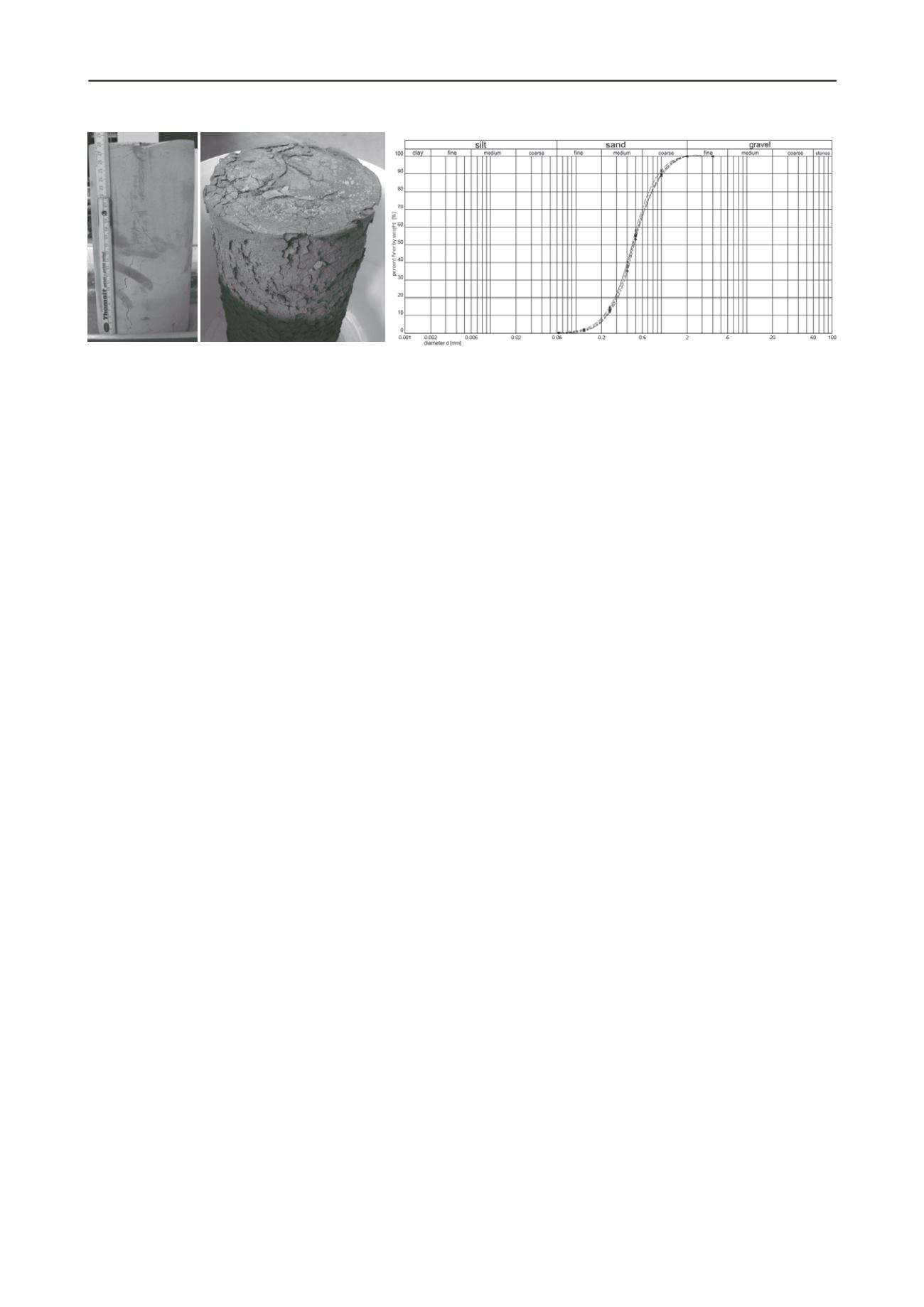
3366
Proceedings of the 18
th
International Conference on Soil Mechanics and Geotechnical Engineering, Paris 2013
Figure 7: Alteration of a blank sample of grout material in
contact with air (left) or with water (right) after two cycles
Figure 8: Grade curves of sand used for the experiments before and after freeze thaw
cycles
Most frost damages at the surface of grouting material appear
when the material is as blank sample directly in contact in water
(see figure 7). The unconfined compression tests confirm the
fact that freeze thaw cycles have more negative influence on the
structure of blank samples of grouting material which are in
contact with water, showing in fact a reduced compression
strength.
In case of tests with grouting material and watersaturated
sand, prelevements of the sand surrounding the grouting
material would be carried out. The corresponding grading
curves before and after the freeze thaw cycles are similar
(figure 8), pointing out that the surface is less altered if sand
surronds the sample despite a contact with water and that the
presence of this type of soils has a positive effect on the
resistance of grouting material regarding freeze thaw resistance.
Due to the level of the effective pressure and permeability of the
soil, water is pushed out the sample and pore volumes do not
increase during icing.
5 CONCLUSIONS
Freeze thaw resistance of the system concerns not only the
resistance of the grout material, but also of the surrounding soil
and the interface between the two elements. Fine grained soils
would be more critical than coarse grained soils regarding
freeze thaw effects. Nevertheless, results presented in the
literature for those types of soils show that such effects are
fastly reduced with increasing effective pressure.
A real alteration of the system does not appear here,
confirming a positive influence of the soil on the frost resistance
of the system soil-grouting. Considering damages documented
in reports, results from the literature and from the present
experiments leads therefore to conclude that most frost damages
would appear on the ground surface and concern more external
elements such as distribution devices or pipes for the connection
between building and borehole heat exchanger rather than
grouting materials in the forage. Comparing the overall state of
stress in the soil along a geothermal borehole heat exchanger
with the stresses from freeze-thaw cycles observed in the
presented investigations does not suggest the occurance of
damages from the operation of a geothermal borehole heat
exchanger even in peak load and with freeze-thaw cycles.
6 REFERENCES
Andersland, O., B., Ladanyi, B. 2004.
Frozen Ground
Engineering
. John Wiley & sons, New Jersey, ‘Appendix C:
Laboratory and Field Tests on Frozen Soils’, 315-367
Bassetti S., Rohner E. and Signorem S. 2006.
Dokumentation
von Schadensfällen bei Erdwärmesonden
. Schlussbericht,
Geowatt AG und Ingénieurs-Conseils SA, EnergieSchweiz.
DIN CEN TS 12390-9:2006.
Testing hardened concrete. Freeze
Thaw Resistance
. (German Version). Deutsches Institut für
Normung.
DIN EN 12371:2010.
Natural stones test methods –
Determination of frost resistance
. (German Version).
Deutsche Institut für Normung.
DIN EN 1367-1:2007.
Tests for thermal and weathering
properties of aggregates. Determination of resistance to
freezing and thawing
. (German Version). Deutsches Institut
für Normung.
DIN 52104:1982.
Prüfung von Naturstein - Frost-Tau-Wechsel-
Versuch
. Deutsches Institut für Normung.
Herrmann J. 2008.
Ingenieurgeologische Untersuchungen zur
Hinterfüllung
von
Geothermie-Bohrungen
mit
Erdwärmesonden
. Dissertation , Fakultät für Bauingenieur-,
Geo- und Umweltwissenschaften der Universität
Fridericiana (TH), Karlsruhe.
Müller L. 2009.
Frost-Tau-Widerstand von Verfüllbaustoffen
für Erdwärmesonden
. Beitrag „Der Geothermiekongress
2009“ Bochum.
Niederbrucker R., Steinbacher N. 2008.
Eignungsuntersuchung
von Verpressmaterialien für Erdwärmesonden
. Technischer
Endbericht, Land Oberösterreich.
Reuter, F., Klengel, J., Pasek, J. 1992
. Ingenieurgeologie. 3.
Auflage
, Deutscher Verlag für Grundstoffindustrie GmbH,
Leipzig-Stuttgart
Ruckli R. 1950.
Der Frost im Baugrund
. Wien Springer-Verlag.
Simonsen, E., Isacsson, U. 2001.
Soil behavior during and
thawing using variable and constant confining pressure
triaxial tests
. Canadian Geotechnical Journal, 38(4), 863-
875
ZTVE-StB 94. Bundesministerium für Verkehr. 1994.
Zusätzliche
Technische
Vertragsbedingungen
und
Richtlinien für Erdarbeiten im Straßenbau
. FGSV Verlag
GmbH.


